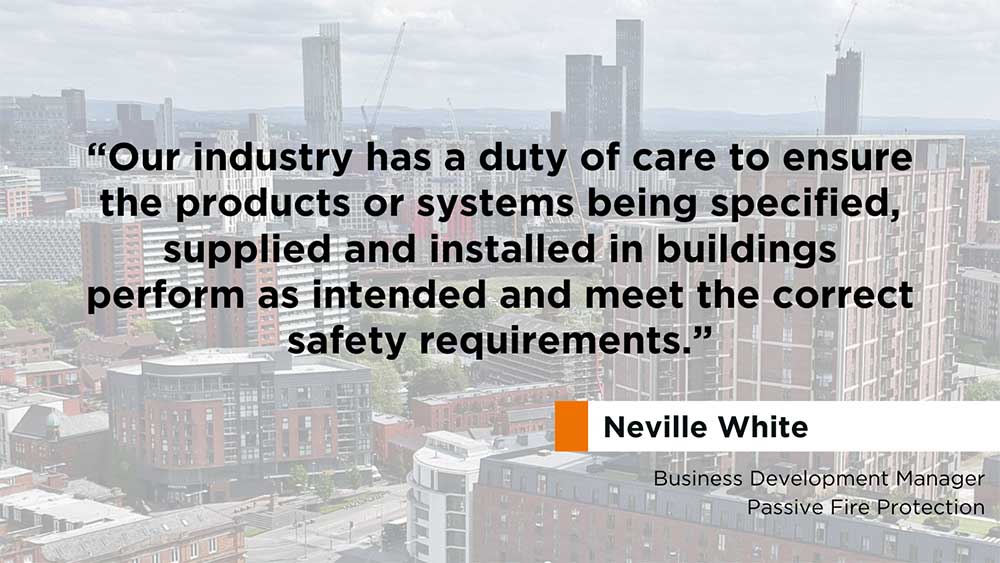
I have worked in fire protection for over 30 years, and during this time have seen many fire incidents in buildings, with Lakanal House in 2009 and the Grenfell Tower fire in 2017 among the most tragic. However, Grenfell has pushed the construction industry more than ever before to improve the quality and safety of buildings. A first step by Government was to appoint Dame Judith Hackitt to lead an independent review of building regulations and fire safety, and over the last five years construction, its products – particularly cladding and insulation – and its practices have undergone intense scrutiny.
I’m sure many of us have been following the Inquiry and have been listening in astonishment at the damaging revelations and stark truths. It also brings to the fore the realisation that existing regulation fell short in multiple areas, ultimately leading to the loss of life and the risk to many others. Our industry is being held accountable and lessons need to be learnt.
Although five years may seem a long time, particularly for the many families impacted by Grenfell, we are seeing fundamental change with the Building Safety Bill receiving Royal Assent and being passed into law as the Building Safety Act 2022. The new Act, detailed over 252 pages, is intended to “create lasting generational change” to the way high-risk and residential buildings are constructed and maintained and ensuring better protection for leaseholders.
The new law has also triggered updates and amends to other laws such as the Landlord & Tenant Act of 1985, the Defective Premises Act of 1972 and the Building Act of 1984, and we see the ‘golden thread’ of information included in law too. Lord Stephen Greenhalgh, the Minister for building safety, called the bill the “biggest changes in building safety legislation in our history.”
The Act addresses key issues that have been at the forefront of many discussions since the Grenfell tragedy such as who pays for the cladding crisis and the remediation of historic defects. Until recently leaseholders have borne the cost of extortionate bills on properties they purchased in good faith and have also been prevented from selling their homes. This new law will protect leaseholders from remediation costs for historic fire safety defects.
Leaseholders will also be able to undertake retrospective legal action, going as far back as 30 years, against developers or contractors that have built unsafe properties.
The Act may not deliver what everyone was hoping for, and it will take time for regulatory change and cultural shifts to filter through to behaviour and standard practice. However, it is a positive milestone in prioritising building safety. Secondary legislation will provide the detail, but fundamentally this development represents an obligation to improve the way we build.
It’s been hard for the industry and Government to get to this point because the construction supply chain is complicated. Levelling-Up Secretary Michael Gove is holding private developers and construction product manufacturers to account for their part in contributing to the building safety crisis, and 35 national developers and housebuilders have agreed to fund major building safety repairs. But accountability cannot be aligned so directly to individual product manufacturers as responsibility for what is installed is often shared.
During a project, specifications pass through many hands and different levels with the opportunity and incentive to switch products and brands, based on the concept of equivalence. This assumes products and brands can be switched without risk, or minimal risk. It’s a convenient idea, but those who decide to switch are frequently not in a position to know the consequences of substituting products or brands. This is particularly true when they’re part of a system that was designed to perform as a whole and deliver a calculated performance in energy efficiency, fire safety, or sound.
Culture transformation across the supply chain is a vital cog to fundamental change. Manufacturers, distributors and merchants through to main contractors and specialist installers have a duty of care to ensure the products or systems being specified, supplied and installed in buildings perform as intended and meet the correct safety requirements. It is crucial therefore that the performance properties of products, particularly in specialist areas like fire protection, are understood by those recommending or installing.
Distributors are an integral conduit in the supply chain, enabling the delivery of products from manufacturers through to merchants and installers. But the distributor’s role is often underestimated and goes beyond that of a product supplier. Fire protection is a vital element for all buildings, and builders and contractors rely on the expert advice of their local merchant to get the right solutions for their projects, in line with performance and regulatory standards. So it’s important distributors invest in specialist teams to support merchants. Our growing network of Fire Protection Centres include dedicated in-branch technical experts so merchants can benefit from relevant training and advice and build their knowledge to confidently recommend and supply the right solutions to their customers.
By working together we have the opportunity to rebuild public trust in the building supply chain and restore integrity in the buildings we deliver, so Grenfell’s legacy becomes one of safer buildings.